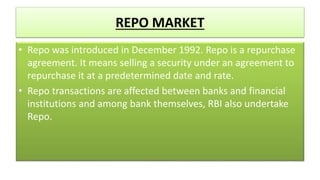Money market
- 1. MONEY MARKET
- 2. Definition Definition: Money market basically refers to a section of the financial market where financial instruments with high liquidity and short-term maturities are traded. Money market has become a component of the financial market for buying and selling of securities of short-term maturities, of one year or less, such as treasury bills and commercial papers.
- 3. Description • Money market consists of negotiable instruments such as treasury bills, commercial papers. and certificates of deposit. It is used by many participants, including companies, to raise funds by selling commercial papers in the market. Money market is considered a safe place to invest due to the high liquidity of securities.
- 4. • The money market is an unregulated and informal market and not structured like the capital markets, where things are organised in a formal way. Money market gives lesser return to investors who invest in it but provides a variety of products.
- 5. *
- 6. Financing trade – Money market plays crucial role in financing both internal as well as international trade. Commercial finance is made available to the traders through bills of exchange, which are discounted by the bill market. Financing industry – Money market helps in securing the short-term loans to meet their working capital requirements through the system of finance bills , commercial papers, etc.
- 7. Profitable investment – Money market enables the commercial banks to use their excess reserves in profitable investment. Self-sufficiency of commercial bank – Developed money market helps the commercial banks to become self-sufficient. Help to central bank – It smoothens the functioning and increases the efficiency of central bank.
- 8. MONEY MARKET INSTRUMENTS Call money market Commercial paper Treasury bills Commercial bills Certificate Of Deposits Money Market Mutual Funds The Repo Market Discount And Finance House Of India
- 9. 1) Call And Notice Money Market :- The market for extremely short-period is referred as call money market. Under call money market, funds are transacted on overnight basis. The participants are mostly banks. Therefore it is also called Inter-Bank Money Market. Under notice money market funds are transacted for 2 days and 14 days period. The lender issues a notice to the borrower 2 to 3 days before the funds are to be paid. On receipt of notice, borrower have to repay the funds. In this market the rate at which funds are borrowed and lent is called the call money rate.
- 10. COMMERCIAL PAPERS Commercial Papers were introduced in January 1990. The Commercial Papers can be issued by listed company which have working capital of not less than Rs. 5 crores. They could be issued in multiple of Rs. 25 lakhs. The minimum size of issue being Rs. 1 crore. At present the maturity period of CPs ranges between 7 days to 1 year. CPs are issued at a discount to its face value and redeemed at its face value.
- 11. COMMERCIAL BILLS • A bill of exchange is drawn by a seller on the buyer to make payment within a certain period of time. Generally, the maturity period is of three months. Commercial bill can be resold a number of times during the usance period of bill. • - Commercial bills are short term, negotiable and self liquidating money market instruments with low risk. • Commercial bill can be resold a number of times during the usance period of bill.
- 12. TREASURY BILLS (t-bills) • Commercial bill can be resold a number of times during the usance period of bill. • Treasury bills are available for a minimum amount of Rs. 25,000 and in multiples of Rs. 25,000. Periodic auctions are held for their Issue. • At present three types of treasury bills are issued through auctions, namely 91 day, 182 day and364day treasury bills. • Interest is determined by market forces
- 13. CERTIFICATE OF DEPOSIT (CD) • The scheme of CDs was introduced in 1989 by RBI. The main purpose was to enable the commercial banks to raise funds from market. • CDs are unsecured, negotiable promissory notes issued at a discount to the face value. • CDs are issued by Commercial banks and development financial institutions. • At present, the maturity period of CDs ranges from 3 months to 1 year. They are issued in multiples of Rs. 25 lakh subject to a minimum size of Rs. 1 crore.
- 14. MONEY MARKET MUTUAL FUNDS (MMMFs) • - A Scheme of MMMFs was introduced by RBI in 1992. The goal was to provide an additional short-term avenue to individual investors. • A money market fund (also called a money market mutual fund) is an open-ended mutual fund that invests in short-term debt securities
- 15. REPO MARKET • Repo was introduced in December 1992. Repo is a repurchase agreement. It means selling a security under an agreement to repurchase it at a predetermined date and rate. • Repo transactions are affected between banks and financial institutions and among bank themselves, RBI also undertake Repo.
- 16. UNORGANIZED MONEY MARKET The unorganized money market mostly finances short-term financial needs of farmers and small businessmen. The main constituents of unorganized money market are:- • Indgenious Bankers • Money Lenders • Non Banking Financial Companies (NBFCs)
- 17. Indigenous bankers • Indigenous bankers are individuals or private firms who receive deposits and give loans and thereby operate as banks. IBs accept deposits as well as lend money. They mostly operate in urban areas, especially in western and southern regions of the country. • Further their lending operations are completely unsupervised and unregulated.
- 18. MONEY LENDER (MLs) They are those whose primary business is money lending. Money lending in India is very popular both in urban and rural areas. Interest rates are generally high. Large amount of loans are given for unproductive purposes. The operations of money lenders are prompt, informal and flexible. The borrowers are mostly poor farmers, artisans, petty traders and manual workers.
- 19. Non Banking Financial Companies • Chit funds: are savings institutions. It has regular members who make periodic subscriptions to the fund. The beneficiary may be selected by drawing of lots. Chit fund is more popular in Kerala and Tamilnadu. RBI has no control over the lending activities of chit funds. • Nidhis: -Nidhis operate as a kind of mutual benefit for their members only. The loans are given to members at a reasonable rate of interest. Nidhis operate particularly in South India. • Finance Brokers:- They are found in all major urban markets specially in cloth, grain and commodity markets. They act as middlemen between lenders and borrowers. They charge commission for their services.
- 20. Players of money market • Government - The government is the most active player and the largest borrower in the money market. • Reserve bank of India - The unorganised money market comes under the direct regulation of RBI. It plays the role of merchant bankers to the government. • Commercial bank - Commercial bank lending and undertaking of short –term funds and have major impact on interest structure and liquidity position.
- 21. Players of money market • Financial institution-They lend money to banks by rediscounting bills of exchange. • Corporate firms – It operates in money market to raise short- term funds to meet their working capital requirements. • Dealers- It is the intermediaries of the money market. It is introduced by RBI for developing an active secondary market for government securities.




















